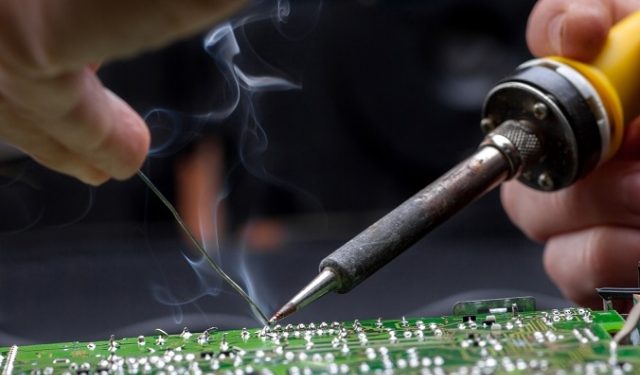Soldering can be a tricky skill to master. However, with enough practice and passion, you can develop to a professional level, but before you get carried away there are few important measures to follow for the sake of your health and safety. Solder and flux contain harmful chemicals, hence do not forget to wash your hands thoroughly after soldering. Make sure you are not breathing fumes formed from soldering fluxes. Keep your working space well ventilated and use soldering-specific fume extraction to restrict this. It goes without saying that you should never touch the element or tip of a soldering iron which can be set between 300-400°C at its working temperature. If by accident you get burned, seek medical attention immediately without following any home remedies.
7 Technical Aspects of Soldering
Now let’s dive into technical aspects of soldering and what should you follow and what to avoid.
1. ESDS Packing
Some components are ESDS (electro-static discharge sensitive) that come in antistatic packaging. You should wear ESD (Electro-static Discharge) protection while handling them for safe usage. Wrist straps, footwear, and smocks are common.
2. Trimming the Soldering
While soldering through-hole components, some operators tend to trim leads after soldering This allows cutting into the solder joint and may put unnecessary stress on the component or board. Common industry practice states you trim it before and not after to prevent this; it will look neater, too.
3. Clean Your Soldering From Oxidation
Keep your soldering tips clean and prevent them from oxidation. Before using soldering iron, put some solder on the tip, which will be coated around the top. It’s called tinning and provides a better transfer of heat from the soldering tip to joints. You can also apply tip cleaner (also known as tip tinner or activator). It’s basically a mixture of flux and solder that has a much higher concentration of flux. Preheat the soldering iron, dip it in the tip activator, and twist to cover the whole trip. Wiping on a damp sulfur-free sponge or on a brass braid to remove oxidation is common. To prevent this always tin your tip before returning it to the holder. This allows the solder to oxidize and not the tip.
4. Temperature of Your Soldering
The temperature of your soldering iron impacts tip life as well. Keep the temperature level at an optimum to avoid overheating of the soldering tip. This principle also applies when you aren’t actively using your iron. It is advisable to turn off the soldering station while not using it for significant periods. Modern iron with hibernate or sleep to help this and heat to full temperature when removed from the holder.
5. Lead-Free Solders
Since a vast majority of countries including the UK have adopted lead-free solders, the working temperature has been raised by 20-100°C; It has significantly increased the chances of damaging components of PCBs. Remember some components are more susceptible to heat damage than others. The use of pre-heating or auxiliary heating may help reduce the tip temperature if this becomes a problem. Equally heat sinks and thermal shunts can dissipate unwanted heat.
6. Melting the Soldering Iron
Transfer soldering in beginners or untrained personnel that melt the solder on the soldering iron first instead of joints. No matter how easy and convenient it seems, it’s a bad practice to follow. Remember, your soldering iron should be in contact with component lead and pad while you touch soldering wire at joints, not to soldering iron. Transfer soldering burns off the flux required to clean the joint area and lowers the amount of heat during the soldering process. This leads to poor setting and cold solder connections.
7. Do Not Burn Solder
It is likely that your solder might get burnt during the initial stage of training. Burnt solder is neither a good conductor of electricity nor mechanically susceptible to hold components longer. However, you can fix that by removing burnt solder with a vacuum desoldering tool or copper braid, subsequently adding extra solder at joints.
Contact Advanced Rework Technology Today
If you currently do not have globally recognized IPC certification in your institute or on your resume and you want to make that superior change, contact Advanced Rework Technology (A.R.T.) today. A.R.T Ltd also offers bespoke training that can be based entirely around the requirements of your company and even specific products, with all theory and practical equipment supplied by them too. All is just a call away from you. Call A.R.T. Ltd today on 01245 237 083.
Follow Techdee for more informative articles.





